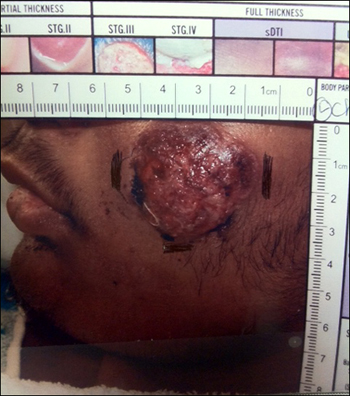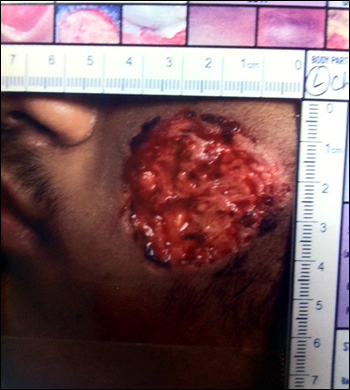A 16-year-old boy with a left facial ulcer
Click Here to Manage Email Alerts
A 16-year-old male with a complex psychiatric history — fetal alcohol syndrome, mental retardation, bipolar disorder, attention-deficit/hyperactivity disorder and schizophrenia — and Crohn’s disease presents to the ED with a 3-day history of worsening left-sided facial swelling. The patient developed a pimple on the left side of the face 3 days prior to being seen. The lesion has grown in size with increasing erythema and edema.
On the morning of admission, the patient developed a fever of 102°F. His mother is unaware of any insect bites, other rashes, trauma or allergic reactions that might have occurred. Review of systems is otherwise unremarkable.
The patient’s current medications include aripiprazole, azathioprine, clonidine, polyethylene glycol (MiraLax, Schering-Plough), esomeprazole magnesium (Nexium, AstraZeneca), oxcarbazepine, prednisone and risperidone. His immunizations are up-to-date.
On physical examination, he has a 3-cm by 3-cm facial edematous mass with surrounding erythema spreading to the left eye, sparing the extraocular muscles. The entire spread measures approximately 8-cm by 7-cm with a healing scab at the center with a well-demarcated border. The area is tender to the touch with no pus or blood drainage. The neck is soft, supple without any masses or lymphadenopathy. The rest of his examination is unremarkable.
The patient was started on clindamycin and admitted to the hospital with the diagnosis of left facial and periorbital cellulitis and pancytopenia. During the next few days, the lesion becomes ulcerative and continues to expand. It begins to appear more friable with copious amounts of purulent and serosanguinous drainage and was extremely painful to touch.



Can you spot the rash?
Diagnosis: Pyoderma gangrenosum
Pyoderma gangrenosum is a rare noninfectious neutrophilic dermatosis. There are four clinical types of pyoderma gangrenosum: 1) ulcerative; 2) pustular; 3) bullous; and 4) vegetative.
The clinical presentation of pyoderma gangrenosum can occur almost anywhere on the body. However, it occurs most commonly on the lower legs, especially over the pretibial area. Extracutaneous manifestations include involvement of the upper airway mucosa, pulmonary and splenic infiltrates. The general incidence of pyoderma gangrenosum has been estimated to be between 3 million and 10 million per year. The peak incidence occurs among patients aged 20 to 50 years. Although it affects both sexes, there is a slight predominance in women. Children account for only 3% to 4% of the total number of cases.
Diagnosis of pyoderma gangrenosum is based on clinical findings and supported by biopsy. Knowledge of the patient’s history for possible underlying disease is crucial. The histopathology of pyoderma gangrenosum is nonspecific/inflammatory and changes with a predominance of lymphocytes and neutrophils.
Differential diagnosis
The differential diagnoses of pyoderma gangrenosum include vascular occlusive or venous disease, other vasculitities such as Wegener’s disease or phospholipid syndrome; cancers such as leukemia; lymphomas; infections such as ecthyma, deep mycoses, lay syphilis vs. herpetic lesions; exogenous tissues; and injury such as necrotizing skin ulcers from insect bites and drug reactions.
Treatment for pyoderma gangrenosum begins with systemic corticosteroid therapy. Initial high-dose therapy is used to prevent progression and rapidly stop inflammation. This treatment may cause fatal side effects in patients with cardiovascular disease who are on diuretics. Other therapies include the use of cyclosporine, sulfa drugs, clofazimine (Lamprene, Novartis), thalidomide (Thalomid, Celgene Corp.) and other cytotoxic drugs.
Treatment is often targeted toward controlling inflammatory bowel diseases when present. The most effective treatment for pyoderma gangrenosum is targeting the underlying cause.
Blood counts and transaminases should be monitored. Topical treatment is important with any type of ulcerative lesion. The use of foam dressings or laminated dressings is typically recommended when heavy exudates are present. Wet compresses with sterile saline solution are used at wet-to-moist wound dressings. It is also important to provide good pain relief during wound changes.
– Written/contributed by Aleen Chin, MD, and Pisepong Patamasucon, MD
For more information:
- August PJ. Br J Dermatol. 1974;91(Suppl s10):80-82.
-
Callen JP. Rheum Dis Clin North Am. 2007;33:787-802.
- Dourmishev AL. Cutis. 1996;58:257-262.
- Gettler S. Am J Clin Dermatol. 2003;4:597-608.
- Graham JA. Pediatr Dermatol. 1994;11:10-17.
- Powell FC. J Am Acad Dermatol. 1996;34:395-409.
- Powell FC. Dermatol Clin. 2002;20:347-355.
- Tjandra JJ. Dis Colon Rectum. 1994;37:938-942.
- Vidal D. J Dermatolog Treat. 2004;15:146-152.
- Wollina U. Orphanet J Rare Dis. 2007;2:19.
Disclosure: The researchers report no relevant financial disclosures.
